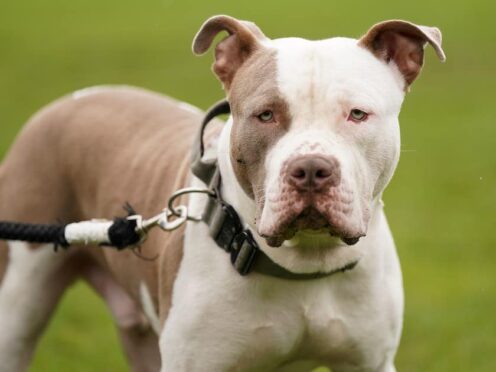
A Holyrood committee has backed the introduction of safeguarding rules on XL bully dogs in Scotland.
It means that from Friday, owners will be banned from selling, advertising, gifting, exchanging or abandoning the breed.
XL bullies must also be muzzled and on a lead in public places.
Criminal Justice Committee MSPs said they “reluctantly” backed the legislative changes, which include a secondary stage meaning that from August 1, it will be an offence to own an XL bully without having or applied for an exemption certificate.
Anyone convicted of breaching the safeguards could face up to six months in prison and/or a fine of up to £5,000.
Siobhian Brown, community safety minister, said the decision to replicate UK Government legislation was “not made lightly” but it was essential to remove “loopholes” the laws had created.
It follows concerns over an influx of XL bullies to Scotland since the controls were brought in south of the border at the end of last year.

She added: “What became clear, after the legislation came into force, was that the UK Government could not confirm that an owner of an XL bully dog who lived in England and Wales and wasn’t able to sell or rehome a dog in England could not do so in Scotland.
“So whilst to do so would be breaching English and Welsh law, it did create a loophole that led to some owners bringing the dogs to Scotland.”
SNP MSP Christine Grahame, who authored the Control of Dogs (Scotland) Act 2010 which gave local authorities powers to impose control notices on dog owners, urged the committee to back her motion to annul the secondary legislation taking effect in Scotland.
Her arguments centred around the failure of the UK and Scottish governments to formally define what an XL bully breed is.
Official guidance states the dogs – which are not recognised as an official breed by the UK Kennel Club – can be defined as having a “muscular body, blocky head, suggesting great strength and power for [their] size”, with males characterised as at least 20 inches from the shoulder to the ground and 19 inches for females.
The motion to annul was unanimously rejected.
Join us at 9am on #SPTV 📺when we’ll question Victims and Community Safety Minister @Siobhianayr on the Dangerous Dogs (Designated Types) (Scotland) Order 2024. Will also consider a motion to annul the Order. Watch here https://t.co/eYLdVZDVvG pic.twitter.com/xwcbhONGvx
— Criminal Justice Committee (@SP_Justice) February 21, 2024
Ms Grahame said: “The problem too is the unintended consequences. Dogs will have been put down, others will have been neutered, people will have been persecuted because that social media which is providing this very flimsy evidence of the number of dogs coming up will be a hotspot for reporting people.
“The police will be sent out – who have enough on their plate – to measure a dog with a tape measure to see if it complies to the confirmation that has been invented by Defra (UK Department for Environment, Food and Rural Affairs).”
Ms Grahame said “there will be court cases” challenging the definition.
Scottish Conservative MSP Russell Findlay questioned Ms Brown on why it had taken so long for ministers in Scotland to replicate UK law, which was in force from December 31.
He said: “We welcome wholeheartedly the Scottish Government finally coming to the right decision.
“Was this a case of spectacular poor judgment, dithering, or simply an opportunity to seek divergence with the rest of the UK?”
Ms Brown replied: “I would say neither of those suggestions.”

Enjoy the convenience of having The Sunday Post delivered as a digital ePaper straight to your smartphone, tablet or computer.
Subscribe for only £5.49 a month and enjoy all the benefits of the printed paper as a digital replica.
Subscribe